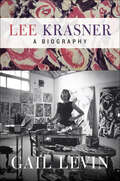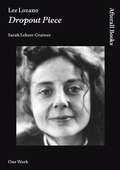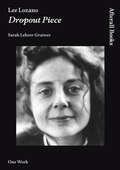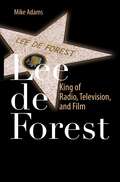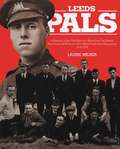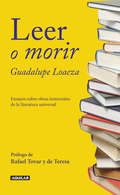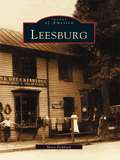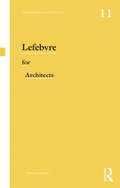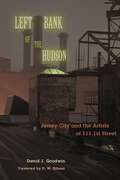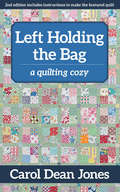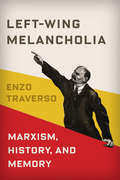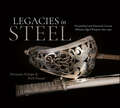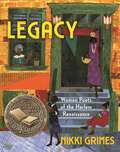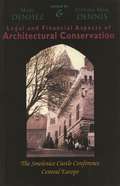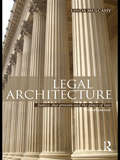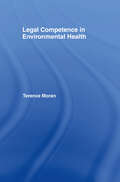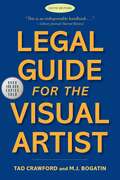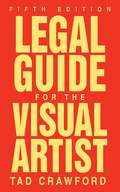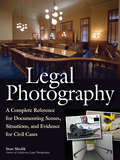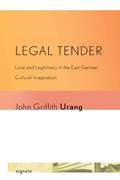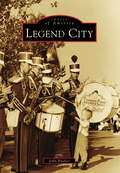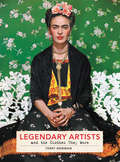- Table View
- List View
Lee Krasner: A Biography
by Gail LevinA “compelling” biography of the brilliant abstract expressionist painter who was far more than just Mrs. Jackson Pollock (Los Angeles Times).Lee Krasner is best known as the artist-wife of Jackson Pollock, the renowned abstract expressionist painter. Yet in this riveting biography, the first full-length account of her colorful life, Krasner emerges as a significant artist who deserves her place in the twentieth century’s cultural lexicon.In this captivating book, art historian Gail Levin probes Krasner’s relationship with Pollock, examining how this strong woman struggled to meet the challenges of their poverty, as well as her husband’s alcoholism and extramarital affair, all the while encouraging his art. Drawing on new sources and numerous personal interviews—including with Krasner herself—Levin has written a dynamic and moving portrait of a brilliant woman, a most welcome work that recovers Krasner’s voice and allows us to understand how her life intersected with and informed her art.
Lee Lozano
by Sarah Lehrer-GraiwerThe artist Lee Lozano (1930--1999) began her career as a painter; her work rapidly evolved from figuration to abstraction. In the late 1960s, she created a major series of eleven monochromatic Wave paintings, her last in the medium. Despite her achievements as a painter, Lozano is best known for two acts of refusal, both of which she undertook as artworks: Untitled (General Strike Piece), begun in 1969, in which she cut herself off from the commercial art world for a time; and the so-called Boycott Piece, which began in 1971 as a month-long experiment intended to improve communication but became a permanent hiatus from speaking to or directly interacting with women. In this book, Sarah Lehrer-Graiwer examines Lozano's Dropout Piece, the culmination of her practice, her greatest experiment in art and endurance, encompassing all her withdrawals, and ending only with her burial in an unmarked grave. And yet, although Dropout Piece is among Lozano's most important works, it might not exist at all. There is no conventional artwork to be exhibited, no performance event to be documented. Lehrer-Graiwer views Dropout Piece as leveraging the artist's entire practice and embodying her creative intelligence, her radicality, and her intensity. Combining art history, analytical inquiry, and journalistic investigation, Lehrer-Graiwer examines not only Lozano's act of dropping out but also the evolution over time of Dropout Piece in the context of the artist's practice in New York and her subsequent life in Dallas.
Lee Lozano: Dropout Piece (One Work)
by Sarah Lehrer-GraiwerAn examination of Lee Lozano's greatest experiment in art and endurance—a major work of art that might not exist at all. The artist Lee Lozano (1930–1999) began her career as a painter; her work rapidly evolved from figuration to abstraction. In the late 1960s, she created a major series of eleven monochromatic Wave paintings, her last in the medium. Despite her achievements as a painter, Lozano is best known for two acts of refusal, both of which she undertook as artworks: Untitled (General Strike Piece), begun in 1969, in which she cut herself off from the commercial art world for a time; and the so-called Boycott Piece, which began in 1971 as a month-long experiment intended to improve communication but became a permanent hiatus from speaking to or directly interacting with women. In this book, Sarah Lehrer-Graiwer examines Lozano's Dropout Piece, the culmination of her practice, her greatest experiment in art and endurance, encompassing all her withdrawals, and ending only with her burial in an unmarked grave. And yet, although Dropout Piece is among Lozano's most important works, it might not exist at all. There is no conventional artwork to be exhibited, no performance event to be documented. Lehrer-Graiwer views Dropout Piece as leveraging the artist's entire practice and embodying her creative intelligence, her radicality, and her intensity. Combining art history, analytical inquiry, and journalistic investigation, Lehrer-Graiwer examines not only Lozano's act of dropping out but also the evolution over time of Dropout Piece in the context of the artist's practice in New York and her subsequent life in Dallas.
Lee de Forest
by Mike AdamsThe life-long inventor, Lee de Forest invented the three-element vacuum tube used between 1906 and 1916 as a detector, amplifier, and oscillator of radio waves. Beginning in 1918 he began to develop a light valve, a device for writing and reading sound using light patterns. While he received many patents for his process, he was initially ignored by the film industry. In order to promote and demonstrate his process he made several hundred sound short films, he rented space for their showing; he sold the tickets and did the publicity to gain audiences for his invention. Lee de Forest officially brought sound to film in 1919. Lee De Forest: King of Radio, Television, and Film is about both invention and early film making; de Forest as the scientist and producer, director, and writer of the content. This book tells the story of de Forest's contribution in changing the history of film through the incorporation of sound. The text includes primary source historical material, U.S. patents and richly-illustrated photos of Lee de Forest's experiments. Readers will greatly benefit from an understanding of the transition from silent to audio motion pictures, the impact this had on the scientific community and the popular culture, as well as the economics of the entertainment industry.
Leeds Pals: A History of the 15th (Service) Battalion (1st Leeds) The Prince of Wales's Own (West Yorkshire Regiment) 1914–1918 (Pals Ser.)
by Laurie MilnerThe British Army&’s losses on the opening day of the Battle of the Somme - 1 July 1916 - amounted to some 57,000 men killed, wounded or missing. Few units, however, suffered as terribly as the famous &‘Pals&’ battalions, raised from volunteers who had flocked to answer Lord Kitchener&’s &‘Call to Arms&’. In the North of England particularly, whole cities and towns went into mourning as news of that awful first day&’s casualties came through. What is less well-known is that some of these battalions were brought up to strength with reinforcements - often from the cities in which they had been raised - and sent back into action again and again This is the story of one such battalion, the Leeds Pals, which by the war&’s end in 1918, was described as having been &‘four times wiped out but fighting to the end&’. It is a story which traces, in great and fascinating detail, the raising and training of the battalion in and around Leeds, their service in Egypt before being sent to France in December 1915, their heavy losses in their baptism of fire on the Somme, 1916, in the Battle of Arras a year later, and during the German offensives of March and April 1918. Based upon the accounts of survivors, private diaries, letters and papers, official archives, contemporary newspaper accounts, and a wealth of unpublished photographs, it is a story of patriotism, enthusiasm, humor, and great courage. Ultimately, however, it is a tale of great tragedy, for though the Leeds Pals took part in the final advance to victory, their three years in France had cost them 733 men killed, 1,861 wounded and 776 missing or captured.
Leer o morir: Ensayos sobre obras inmortales de la literatura universal
by Guadalupe LoaezaLeer o morir es una gran invitación a entrar en los misterios y grandezas de la literatura, una ventana noble donde sabremos de autores y obras que marcaron el espíritu de millones de personas. De Guadalupe Loaeza, autora de Las reinas de Polanco, Primero las damas y Compro, luego existo. Ensayos breves de las obras inmortales de la literatura mundial; genios de la literatura universal que debes de leer antes de morir. Matilde, el personaje femenino de Rojo y negro corta un rizo de su hermoso cabello rubio para darlo a su amado, como prueba de su entrega... la mujer enamorada de La dama del perrito se da cuenta, cuando por fin se reúne con su amante en el hotel, que un abismo de incertidumbre se abre ante ella... ¿quién asesinó realmente al padre de los Karamazov en la genial novela de Dostoievski?... una niña redacta páginas conmovedoras sobre la guerra, laesperanza, el miedo, las ilusiones, en El diario de Ana Frank... ¿encontrará el lector a la Maga de Julio Cortázar? ¿Se conmoverá con el París de los años sesenta, con el jazz, la bohemia y los sueños llenos de ternura? Cuántas historias y enormes deseos, añoranzas, aventuras, amores, traiciones, intrigas, desvelos, horrores, pasiones... nos dejan los libros. En sus páginas la vida se desdobla y nos invita a recorrer otros caminos, nuevas ilusiones, vivir intensamente en otras épocas y latitudes. Con el estilo dinámico, entretenido y lleno de datos precisos y reveladores, que caracteriza la escritura de Guadalupe Loaeza, daremos un paseo por las grandes obras de la literatura universal como El Principito, El lobo estepario, El retrato de Dorian Gray, Ana Karenina, Madame Bovary, El extranjero...sabremos de las inquietudes y obsesiones de Edgar Allan Poe, Carlos Fuentes, Marguerite Yourcenar, Lewis Carroll, Marcel Proust, Albert Cohen, José Saramago, José Emilio Pacheco, J. M. G. Le Clézio ¡y muchos más! Leer o morir es más que un libro amable de recomendaciones y gustos literarios, es una invitación a que siempre, en cualquier momento y circunstancia, el libro sea nuestro amigo más cercano, y generoso.
Leesburg (Images of America)
by Mary FishbackOnce serving as the capital of the United States for three days, the town of Leesburg, Virginia stands at the crossroads of American history. As a rural hinterland of the Washington, D.C. area and situated on the northern fringe of the old Confederacy, Leesburg has seen troops and generals, travelers and settlers, and politicians and presidents walk its streets, and opposing political views tear its population apart. Unity and patriotism returned and characterized the town during the world wars. With the arrival of nearby Dulles International Airport in the 1960s, Leesburg and its surrounding towns experienced a different kind of movement-tremendous population growth.Today, Leesburg is a vital and fast-paced part of Northern Virginia's economy. Yet, despite its modern edge, the town has maintained its old rural character and has striven to preserve its colorful 245-year-old history.
Lefebvre for Architects (Thinkers for Architects)
by Nathaniel ColemanWhile the work of Henri Lefebvre has become better known in the English-speaking world since the 1991 translation of his 1974 masterpiece, The Production of Space, his influence on the actual production of architecture and the city has been less pronounced. Although now widely read in schools of architecture, planning and urban design, Lefebvre’s message for practice remains elusive; inevitably so because the entry of his work into the Anglosphere has come with repression of the two most challenging aspects of his thinking: romanticism and Utopia, which simultaneously confront modernity while being progressive. Contemporary discomfort with romanticism and Utopia arguably obstructs the shift of Lefebvre’s thinking from being objects of theoretical interest into positions of actually influencing practices. Attempting to understand and act upon architecture and the city with Lefebvre but without Utopia and romanticism risks muting the impact of his ideas. Although Utopia may seem to have no place in the present, Lefebvre reveals this as little more than a self-serving affirmation that ‘there is no alternative’ to social and political detachment. Demanding the impossible may end in failure but as Lefebvre shows us, doing so is the first step towards other possibilities. To think with Lefebvre is to think about Utopia, doing so makes contact with what is most enduring about his project for the city and its inhabitants, and with what is most radical about it as well. Lefebvre for Architects offers a concise account of the relevance of Henri Lefebvre’s writing for the theory and practice of architecture, planning and urban design. This book is accessible for students and practitioners who wish to fully engage with the design possibilities offered by Lefebvre’s philosophy.
Left Bank of the Hudson: Jersey City and the Artists of 111 1st Street
by David J. GoodwinIn the late 1980s, a handful of artists priced out of Manhattan and desperately needing affordable studio space discovered 111 1st Street, a former P. Lorillard Tobacco Company warehouse. Over the next two decades, an eclectic collection of painters, sculptors, musicians, photographers, filmmakers, and writers dreamt and toiled within the building’s labyrinthine halls. The local arts scene flourished, igniting hope that Jersey City would emerge as the next grassroots center of the art world. However, a rising real estate market coupled with a provincial political establishment threatened the community at 111 1st Street. The artists found themselves entangled in a long, complicated, and vicious fight for their place in the building and for the physical survival of 111 1st Street itself, a site that held so much potential, so much promise for Jersey City.Left Bank of the Hudson offers a window into the demographic, political, and socio-economic changes experienced by Jersey City during the last thirty years. Documenting the narrative of 111 1st Street as an act of cultural preservation, author David J. Goodwin’s well-researched and significant contribution addresses the question of the role of artists in economically improving cities. As a Jersey City resident, Goodwin applies his knowledge of the city’s rich history of political malfeasance and corruption, including how auspicious plans for a waterfront arts enclave were repeatedly bungled by a provincial-minded city administration. In writing this story, Goodwin interviewed thirteen artists and residents, two businesses, three government officials, and five non-profits, civic organizations, and community activists. The book chronologically explores the history and business of the P. Lorillard Tobacco Company, its evolution into a bustling arts community, the battle to preserve the warehouse as a historic structure, and the lessons to be drawn from the loss and ultimate demolition of the building in 2007, as well as the present state of the neighborhood. Setting the facts straight for future generations, Left Bank of the Hudson provides an illustrative lesson to government officials, scholars, students, activists, and everyday citizens attempting to navigate the “rediscovery” of American cities.
Left Holding the Bag: A Quilting Cozy (A\quilting Cozy Ser. #10)
by Carol Dean JonesA new neighbor and her suspicious foster son keep a senior sleuth on her toes in this mystery by the author of Tattered & Torn. Quilt pattern included!When sixty-eight-year-old Sarah Miller moves into the Cunningham Village retirement community, she is mourning the loss of her husband, her young grandson, and the place that has been home for forty-two years. But Sarah is a survivor. As she reaches out into the retirement community that is to become home, she finds friends, activities, new hobbies, and a possible love interest. The tenth installment of this fun, friendly series of cozy mysteries contains a new friend, trunks full of vintage fabric, credit card fraud, a budding romance, and murder—and Sarah and her friends are at the center of it all.
Left-Wing Melancholia: Marxism, History, and Memory (New Directions in Critical Theory #17)
by Enzo TraversoThe fall of the Berlin Wall marked the end of the Cold War but also the rise of a melancholic vision of history as a series of losses. For the political left, the cause lost was communism, and this trauma determined how leftists wrote the next chapter in their political struggle and how they have thought about their past since. Throughout the twentieth century, argues Left-Wing Melancholia, from classical Marxism to psychoanalysis to the advent of critical theory, a culture of defeat and its emotional overlay of melancholy have characterized the leftist understanding of the political in history and in theoretical critique.Drawing on a vast and diverse archive in theory, testimony, and image and on such thinkers as Karl Marx, Walter Benjamin, Theodor W. Adorno, and others, the intellectual historian Enzo Traverso explores the varying nature of left melancholy as it has manifested in a feeling of guilt for not sufficiently challenging authority, in a fear of surrendering in disarray and resignation, in mourning the human costs of the past, and in a sense of failure for not realizing utopian aspirations. Yet hidden within this melancholic tradition are the resources for a renewed challenge to prevailing regimes of historicity, a passion that has the power to reignite the dialectic of revolutionary thought.
Legacies
by Steven Lubar Kathleen M. KendrickThe Smithsonian Institution has been America's museum since 1846. What do its vast collections -- from the ruby slippers to a piece of Plymouth Rock, first ladies' gowns to patchwork quilts, a Model T Ford to a customized Ford LTD low rider -- tell Americans about themselves? In this lavishly illustrated guide to the Smithsonian's National Museum of American History, Steven Lubar and Kathleen M. Kendrick tell the stories behind more than 250 of the museum's treasures, many of them never before photographed for publication. These stories not only reveal what America as a nation has decided to save and why but also speak to changing visions of national identity.As the authors demonstrate, views of history change over time, methods of historical investigation evolve and improve, and Americas' understand of the past matures. Shifts in focus and attitude lie at the hearth of Legacies, which is organized around four concepts of what a national museum of history can be: a treasure house, a shrine to the famous, a palace of progress, and a mirror of the nation. Thus, the museum collects cherished or precious objects, houses celebrity memorabilia, documents technological advances, and reflects visitors' own lives. Taking examples from science and technology, politics, decorative arts, military history, ethnic heritage, popular culture and everyday life, the authors provide historical context for the work of the Smithsonian and shed new light on what is important, and who is included, in American history. Throughout its history, Lubar and Kendrick conclude, the museum has played a vital role in both shaping and reflecting America's sense of itself as a nation.
Legacies in Steel: Personalized and Historical German Military Edged Weapons, 1800–1990 (Latin America at War)
by Hermann Hampe Rick DauzatNearly 100 German military edged weapons are presented in this sumptuously photographed volume featuring information about their owners. Spanning nearly two hundred years, Legacies in Steel is an in-depth photographic study of historical edged weapons from the German military. The elegant details of each selection are displayed in close-up detail. Many of these weapons belonged to nobility, aristocrats, high-ranking military personnel as well as soldiers and seamen. Where possible, the careers and exploits of these former owners are highlighted, bringing both personal and historical context to these beautifully crafted artifacts. By the 19th century, swords and daggers were no longer effective fighting weapons, but they maintained their popularity in Western Europe as uniform regalia. They were carried as a symbol of authority, achievement, and most importantly, honor. These weapons were produced with great skill and at high cost, requiring the skill of specialized artisans, often using precious metals and ivory, elaborate hand engraving and chiseling. Blades were fabricated of the highest quality Solingen steel. Folded steel Damascus blades were also painstakingly produced. Many examples are unique and border on singular works of art.
Legacy: Women Poets of the Harlem Renaissance
by Nikki GrimesFrom Children's Literature Legacy Award-winning author Nikki Grimes comes a feminist-forward new collection of poetry celebrating the little-known women poets of the Harlem Renaissance--paired with full-color, original art from today's most talented female African-American illustrators.
Legal & Financial Aspects of Architectural Conservation: The Smolenice Castle Conference Central Europe
by Marc Denhez Stephen DennisHow do governments design their strategy for heritage property? What do they try to accomplish in their laws and their tax systems to favour the re-use of older buildings, districts, and cities? What institutional framework can assist the restoration of tourist designations and the conservation of neighbourhoods? In this international study, eighteen experts from ten countries describe the legal challenges and solutions relating to such property. Beyond a carefully described theoretical framework, actual case studies demonstrate how communities and countries can make adjustments to their legislation so that older buildings can be better protected This book stems from an international conference at Smolenice Castle in Slovakia, in November 1994.
Legal Architecture: Justice, Due Process and the Place of Law
by Linda MulcahyLegal Architecture addresses how the environment of the trial can be seen as a physical expression of our relationship with ideals of justice. It provides an alternative account of the trial, which charts the troubled history of notions of due process and participation. In contrast to visions of judicial space as neutral, Linda Mulcahy argues that understanding the factors that determine the internal design of the courthouse and courtroom are crucial to a broader and more nuanced understanding of the trial. Partitioning of the courtroom into zones and the restriction of movement within it are the result of turf wars about who can legitimately participate in the legal arena and call the judiciary to account. The gradual containment of the public, the increasing amount of space allocated to advocates, and the creation of dedicated space for journalists and the jury, all have complex histories that deserve attention. But these issues are not only of historical significance. Across jurisdictions, questions are now being asked about the internal configurations of the courthouse and courtroom, and whether standard designs meet the needs of modern participatory democracies: including questions about the presence and design of the modern dock; the ways in which new technologies threaten to change the dynamics of the trial and lead to the dematerialization of our primary site of adversarial practice; and the extent to which courthouses are designed in ways which realise their professed status as public spaces. This fascinating and original reflection on legal architecture will be of interest to socio-legal or critical scholars working in the field of legal geography, legal history, criminology, legal systems, legal method, evidence, human rights and architecture.
Legal Competence in Environmental Health
by Terence MoranLegal Competence in Environmental Health assists the environmental health professional in understanding the operation of English law and navigating through some of its complexities. It covers those aspects of the work which are regulated by legal principles but not found in a single statute.
Legal Frameworks for the Built Environment
by Jean Badman Laurie GrimmetLaw is a complex subject and has major impacts on the built environment and all those working in it. Law is seen as one of the strongest interdisciplinary links between the various professions; it is essential to have a clear understanding of how both statute and common law, as well as the legislative frameworks (statutory controls/policy and procedures), affect all the roles/areas throughout the built environment. This book will provide students with a broad understanding of the law and its applications, from disputes to land use.
Legal Guide for the Visual Artist
by Tad Crawford M. J. BogatinAn updated edition of the legal art classic. Legal Guide for the Visual Artist is a classic guide for artists. This sixth edition is completely revised and updated to provide an in-depth view of the legal issues facing the visual artist today and provides practical legal guidance for any visual artist involved with creative work. It has been over twelve years since the fifth edition was published, and so much has changed in the world since that time, especially in the law and artists&’ legal rights and obligations. This edition has been updated for both a new generation of visual artists and for those who have purchased earlier editions. Among the many new topics covered in this comprehensive guide are: copyright fair use transformative rights; recognition of the rights of temporal street art in the Five Pointz VARA case; the demise of California&’s Resale Royalty statute; NFTs; detailed coverage of the myriad developments in copyright (including online copyright registration procedures and use of art on the Internet); changes in laws protecting artists in artist-gallery relationships are explained in depth; scope of First Amendment protections for graffiti art and the sale of art in public spaces; detailed as well as new cases dealing with art and privacy; and a model contract for Web site design and much more. The book also covers copyrights, moral rights, contracts, licensing, sales, special risks and protections for art and artists, book publishing, video and multimedia works, leases, taxation, estate planning, museums, collecting, grants, and how to find the best professional advisers and attorneys. In addition, the book suggests basic strategies for negotiation, gives information to help with further action, contains many sample legal forms and contracts, and shows how to locate artists' groups and Volunteer Lawyers for the Arts organizations. Legal Guide for the Visual Artist is a must-have for any visual artist hoping to share, sell, display, or publish their art.
Legal Guide for the Visual Artist
by Tad CrawfordThis classic guide for artists is completely revised and updated to provide an in-depth view of the legal issues facing the visual artist today and provides practical legal guidance for any visual artist involved with creative work. Among the many new topics covered in this comprehensive guide are: detailed coverage of the myriad developments in copyright (including online copyright registration procedures and use of art on the Internet); changes in laws protecting artists in artist-gallery relationships are explained in depth; scope of First Amendment protections for graffiti art and the sale of art in public spaces; detailed as well as new cases dealing with art and privacy; and a model contract for Web site design and much more. The book also covers copyrights, moral rights, contracts, licensing, sales, special risks and protections for art and artists, book publishing, video and multimedia works, leases, taxation, estate planning, museums, collecting, grants, and how to find the best professional advisers and attorneys. In addition, the book suggests basic strategies for negotiation, gives information to help with further action, contains many sample legal forms and contracts, and shows how to locate artists' groups and Volunteer Lawyers for the Arts organizations.
Legal Photography
by Stan SholikWhile the number of assignments available in many photographic specialties is decreasing, there are still relatively untapped growth areas for still photographers and videographers. One of these specialty fields is legal photography. Legal photography involves working closely with lawyers in law firms to provide photographic or video documentation relevant to their civil, not criminal, cases. It can involve a range of other photographic specialties from macro photography to architectural photography. No matter what is involved in a legal photography assignment, it is generally interesting and presents a new, unique set of problems to solve. Legal photography is far more technical than creative, but it is also in demand and is financially rewarding. Civil cases brought to arbitration or jury trial range from simple to complex. Common to all cases is the need to present evidence in a fair and accurate manner. In this book, readers will learn how to take responsibility for ensuring that the images captured and delivered for presentation are a "fair and accurate representation” of the observed scene. That responsibility begins with the choice and use of the proper equipment (e. g. , camera type, sensor size, capture mode, the correct focal-length lens for the job), through the techniques used during image capture (exposure, lighting, camera angle, camera-to-subject distance, white balance, etc. ), to the processing of the captures for output. Sholik also points out that documentation is required for each step to ensure all parties that the representation is indeed fair and accurate-and the details of how this can be accomplished are outlined in this book as well. Also covered is information about how to proceed should you be asked to give testimony as to the accuracy of your work and information about the requirements to be deemed an "expert witness. ” For most photographers, doing assignments in the field of legal photography is the easy part. Getting the assignments can be more of a challenge, so the process of marketing yourself as a legal photographer is covered.
Legal Photography
by Stan SholikWhile the number of assignments available in many photographic specialties is decreasing, there are still relatively untapped growth areas for still photographers and videographers. One of these specialty fields is legal photography.Legal photography involves working closely with lawyers in law firms to provide photographic or video documentation relevant to their civil, not criminal, cases. It can involve a range of other photographic specialties from macro photography to architectural photography. No matter what is involved in a legal photography assignment, it is generally interesting and presents a new, unique set of problems to solve. Legal photography is far more technical than creative, but it is also in demand and is financially rewarding.Civil cases brought to arbitration or jury trial range from simple to complex. Common to all cases is the need to present evidence in a fair and accurate manner. In this book, readers will learn how to take responsibility for ensuring that the images captured and delivered for presentation are a "fair and accurate representation" of the observed scene. That responsibility begins with the choice and use of the proper equipment (e.g., camera type, sensor size, capture mode, the correct focal-length lens for the job), through the techniques used during image capture (exposure, lighting, camera angle, camera-to-subject distance, white balance, etc.), to the processing of the captures for output. Sholik also points out that documentation is required for each step to ensure all parties that the representation is indeed fair and accurate-and the details of how this can be accomplished are outlined in this book as well.Also covered is information about how to proceed should you be asked to give testimony as to the accuracy of your work and information about the requirements to be deemed an "expert witness." For most photographers, doing assignments in the field of legal photography is the easy part. Getting the assignments can be more of a challenge, so the process of marketing yourself as a legal photographer is covered.
Legal Tender
by John Griffith UrangTreating films including Leander Hauss/mann's controversial Sonnenalle (1999), Urang (visiting professor of German, Reed College, Portland, Oregon) explores the question of why in so many East German films and novels love trumps the crumbling political culture of the GDR. Citing Niklas Luhmann's Love as Passion: The Codification of Intimacy as a key influence, he examines how the "semantics of love" interact with socialist-realist processes of authoritarianism. While these love stories draw on the Western tradition, they also critique bourgeois romantic love institutions and practices--a metaphor for reunification with West Germany. Annotation ©2011 Book News, Inc. , Portland, OR (booknews. com)
Legend City
by John BuekerConceived and built in the early 1960s by local artist and advertising man Louis E. Crandall, Legend City was an ambitious and star-crossed mid-century attempt to bring a world-class theme park to the Phoenix metropolitan area. Despite daunting financial challenges and an unforgiving Arizona sun, the park managed to survive for two full decades, entertaining countless Arizonans and forging an enduring place for itself in the hearts and minds of local residents. A sad tale of broken dreams and economic failure on the surface, the story of Legend City is actually an exhilarating and fascinating chapter in the cultural history of Arizona.
Legendary Artists and the Clothes They Wore
by Terry NewmanWhether it’s Cecil Beaton’s flamboyant, classically tailored suits, Frida Kahlo’s love of bright color, or Cindy Sherman’s penchant for minimalism, an artist’s attire often reflects the creative and spiritual essence of his or her work. In Legendary Artists and the Clothes They Wore, fashion authority Terry Newman presents more than forty fully illustrated profiles of masters whose enduring art bears an idiosyncratic stamp—and whose unique way of dress does the same through a signature look, hairstyle, or accessory—and explores the relationship between the two in detail. In that context, this colorful volume also examines the nonlinear sensibility that has always been the name of the game in what is considered modern style. It examines the dialogue between art and fashion as well as noteworthy artist and designer relationships, such as Yves Saint Laurent’s Mondrian Collection, primary-colored shift dresses inspired by the painter’s work, and Louis Vuitton’s numerous groundbreaking collaborations with major artists, a concept initiated by designer Marc Jacobs that not only has launched some of the fashion industry’s most successful bags, made the art of contemporary masters available to the world at large, and been copied widely ever since. Numerous compelling features—anecdotes about the artists and their work; portraits of the artists in their studios; archival photographs; select pairings of fine art and runway imagery; quotations by artists, art critics, and designers—make this a rich, engaging study for fashion and art lovers alike.
